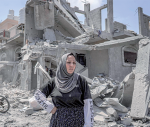You are here
‘Hints’ of an end to Yemen’s nightmare
Apr 11,2016 - Last updated at Apr 11,2016
For decades now, Yemen’s people have suffered from bad governance, underdevelopment and prolonged civil conflict.
Despite enduring these multiple hardships, Yemenis have largely been ignored by the rest of the world.
During the past year, Yemen’s pain has been compounded by a devastating air war. Earlier this week, The New York Times ran an editorial under the promising headline “Hints of an end to the fighting in Yemen”.
The “hints” were that recent meetings between the Saudi government and elements of Yemen’s rebel leadership concluded with announcements of: a prisoner exchange, an April 10 ceasefire and peace talks set to begin a week later in Kuwait.
The assessment of some analysts was that the Times might be overly optimistic, but there is at least some hope that Yemen may be turning a corner.
While there have other periods of upheaval in Yemen’s past, the recent chapter began in the aftermath of the unrest that rocked the country in the wake of the Arab Spring.
Yemen had long been a desperately poor country that, even in the best of times, had been politically unstable. There were tribal conflicts; a conflict between the distinct political cultures of the north and south of the country — a legacy of the colonial era; and home to a branch of Al Qaeda.
The decades-long administration of president Ali Abdullah Saleh, once heralded by the Clinton administration as a model “emerging democracy”, had ossified and become corrupt with rampant nepotism.
What the Arab Spring demonstrators wanted was an end to Saleh’s corrupt rule and a number of political and economic reforms.
As the country convulsed in unrest, the Gulf Cooperation Council (GCC), together with the UN, intervened, attempting to stabilise the situation by making modest reforms in the governance of Yemen.
The agreement they reached led to the removal of “president for life” Saleh, replacing him with his vice president, Abed Rabbo Mansour Hadi, and a government of technocrats.
On replacing Saleh, Hadi laid out a reform agenda that Saleh, who never left the country, opposed and worked to obstruct.
Without full domestic backing, and due to lack of time and resources needed to make real change, the reform effort floundered.
It was at that point that the Hadi government was overthrown by an invading band of rebels in coalition with elements of Yemen’s army who had remained loyal to the deposed president Saleh.
As the rebels moved from the capital, Sanaa, southwards, Saudi Arabia and its GCC partners became concerned. They were angered that the compromise they had worked to achieve had been undone.
Because Saudi Arabia had fought Houthi rebel incursions into its territory, it was loathe to see a Houthi-Salah controlled regime to its south.
What heightened its upset were the boasts coming from some in Iran who claimed that they, that is Iran, now had a presence in four Arab capitals: Baghdad, Damascus, Beirut and Sanaa.
While there had been some debate as to the extent of Iranian support for the Houthi takeover, the Iranian claims and reports of Iranian shipments of arms and supplies to Sanaa created a reality the Saudis would not ignore or tolerate.
Already reeling from the perception that Iran had become an ascendant power in Iraq and from Iran’s political and military involvement in supporting the Assad government in Syria, the Saudis were determined to draw the line in Yemen.
Compounding their concern were the P5+1 negotiations with Iran over Tehran’s nuclear programme.
Saudi Arabia and other GCC countries, correctly or not, feared that this process would not only result in a nuclear agreement, but would legitimise Iran in the eyes of the West, end sanctions and free up billions of dollars providing the Iranians with resources to pursue their quest for regional hegemony.
And so, a year ago, a Saudi-led coalition began air strikes with the intention of turning back the Houthi rebellion and restoring the Hadi government.
As a result of this air campaign, last year has been especially devastating for Yemen.
It has been a war that no one has won — with the Yemeni people paying the greatest price.
According to United Nations statistics, over 6,000 were killed, 30,000 wounded, and 2.5 million have been internally displaced.
Because of Yemen’s difficult and unwelcoming terrain and the fact that it is surrounded on two sides by water, there is nowhere for refugees to go.
Twenty-one million Yemenis are in dire need of humanitarian care, including 19 million who lack clean water and sanitation, 14 million who lack healthcare and over 2 million (of whom, 300,000 are children) who face severe malnutrition.
Saudi Arabia’s regional role has been tarnished by continued reports of civilian targets being hit by its air strikes — with many human rights organisations charging that the attacks constitute war crimes.
Taking advantage of the chaos and resentment of the air war, Al Qaeda in the Arabian Peninsula expanded its reach in the country. And the US has been compromised by its acquiescence to (and provision of military supplies that have enabled) the devastating bombing campaign.
And so, it can only be hoped that the hints are in fact more than just “hints”, that the warring sides have come to the conclusion that this madness must end, and that negotiations will usher in a process of political compromise and national reconciliation, restoring the Hadi government.
At this point, the real agenda for Yemen will not only include political reform and a unifying of Yemeni and regional forces to defeat Al Qaeda, but reconstruction and a major international effort, led by the GCC and the US, to address the fundamental needs of Yemen’s long-suffering people.













